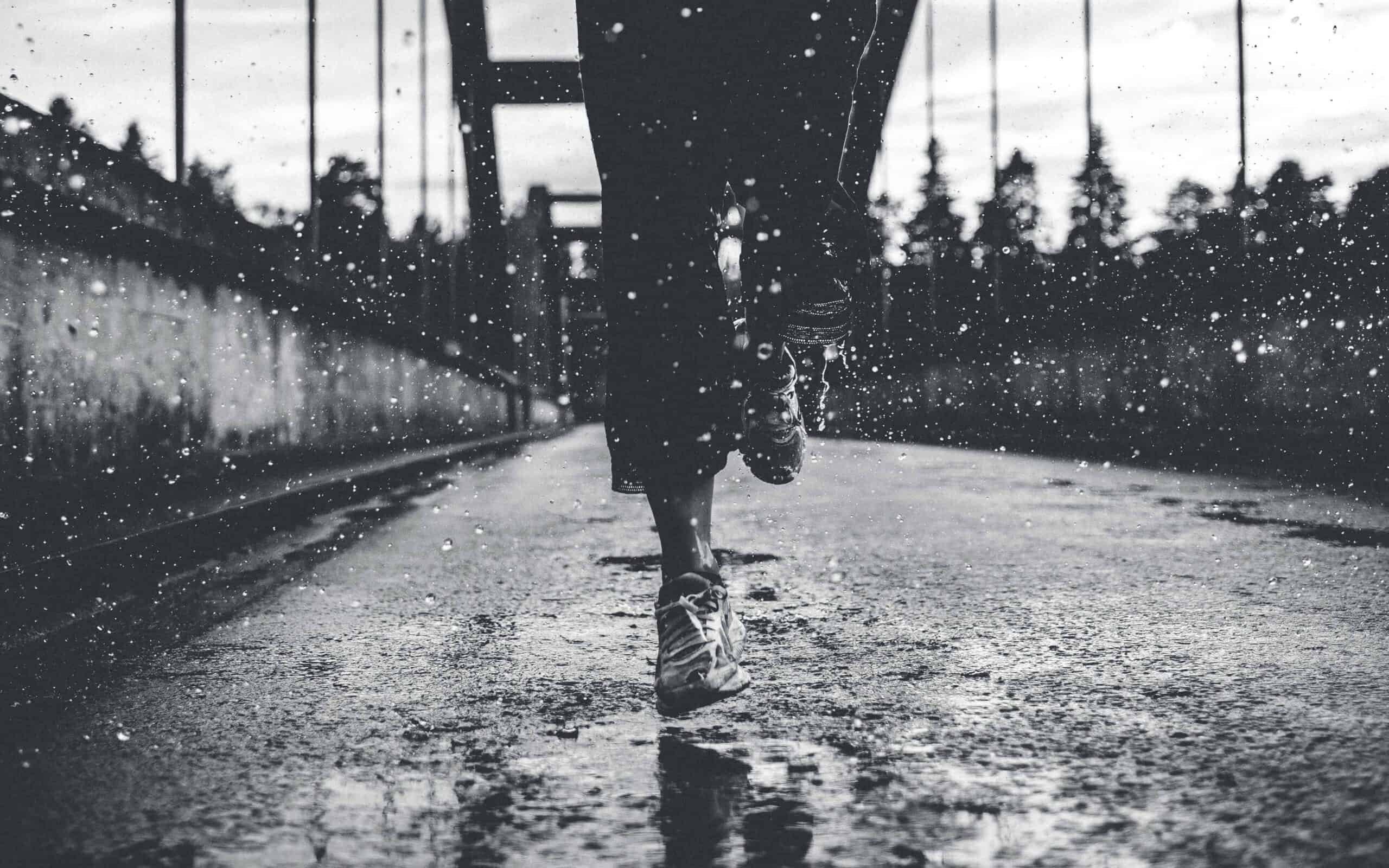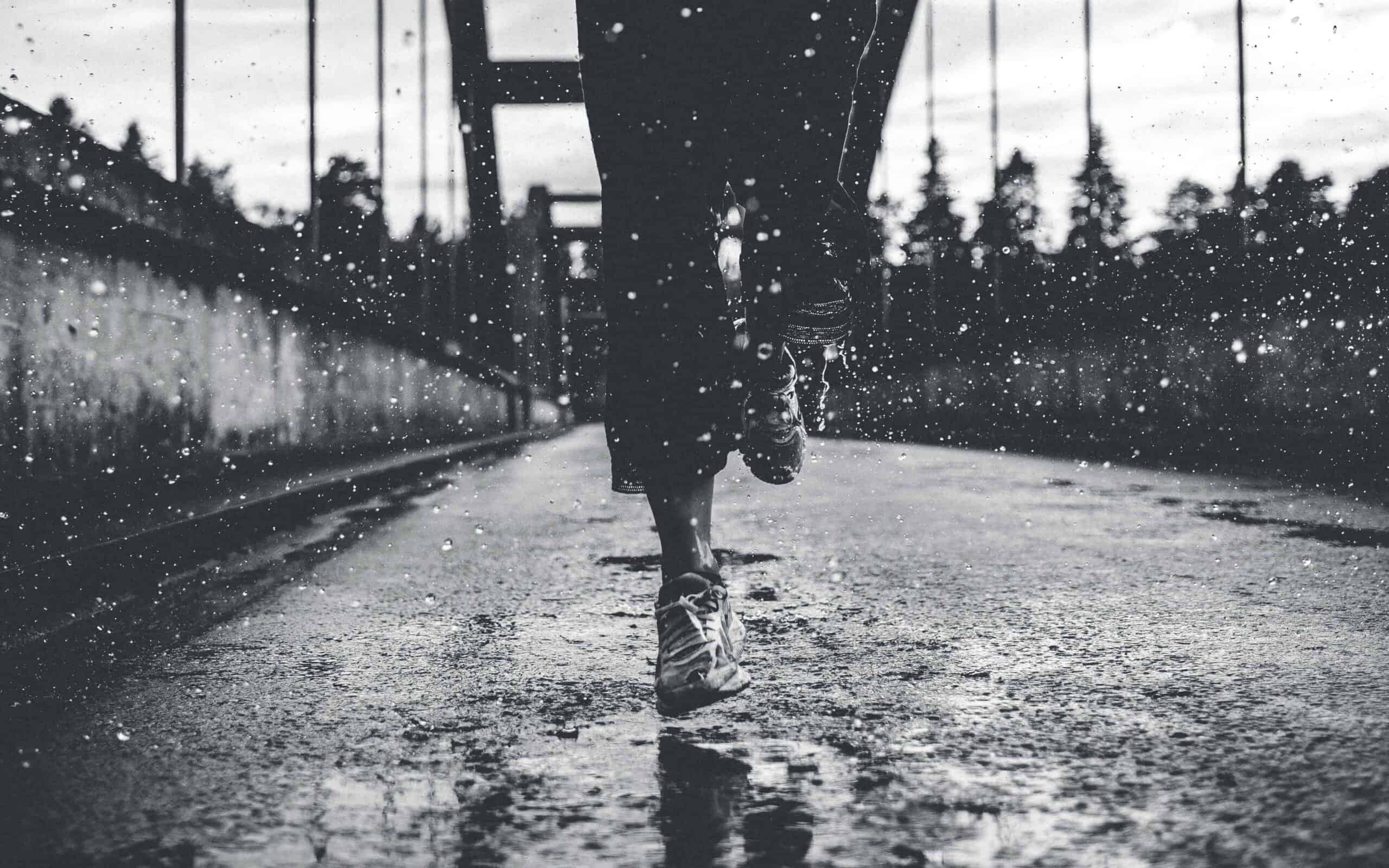You know the feeling. It’s Saturday. Time for your long run. You’ve been looking forward to it all week. The blood, sweat, tears, and glory of it all. But, alas, you look at the forecast and see you might be running in the rain.
As a runner and fellow human being, you’re probably familiar with the challenges of running in the rain. Feet slipping on the sidewalk, damp clothing, wet socks – it can be a real pain.
But, with the right mindset, essential gear, and following our guidance on a few simple tips and tricks, you can beat the rain and make the most of your wet workout.
Don’t let a few raindrops ruin the day.

Is it OK To Run in the Rain?
As runners, we love to push ourselves. That could be whether it’s a heavy downpour or sunny skies. Is it still okay to go for a run if it’s a drizzle? How about a thunderstorm?
First, rain can make running feel much easier.
Traditionally rain brings along colder temperatures, which can lower your own internal body temperature. There’s also some runners who swear there’s nothing quite like experiencing the smells and sounds of the rain during a calming run.
However, there will be hazards.
Rainfall on the sidewalk, roads, and trails will make them slick and is likely to cause slips and falls. In order to reduce the risk of injury in the rain, invest into waterproof running shoes like the Brooks Ghost GTX 15.
Rain also limits visibility during any time of the day which making it harder for drivers to see you, too. You can explore our guide for a full list of protective gear for both sunny and rainy runs.
Ultimately, it’s perfectly fine to run in the rain. Many runners even prefer it to sunny running, in fact! We don’t personally know any of them but we suspect they live in the Pacific Northwest.
Why running in the rain is great for training
There’s just something about running in the rain that is so satisfying. Maybe it’s the peacefulness of the falling drops or the cool, refreshing feeling on your skin.
Here are a few reasons why you might want to not skip your regularly scheduled run on your next rainy day, rather than hitting the treadmill or skipping your workout entirely.
Running in the rain may build mental toughness
Running in the rain takes a little bit of extra motivation and willpower to get out there. But once you do, you’ll feel like you can conquer anything.
The mental toughness you build while running in the rain will translate into many other areas of your life, too. If you can run 5 miles in the rain, your mind and body can handle the stress of running 10 miles in sunshine.
Rain will lower your body temperature
One of the reasons people love running in the rain is the decrease in temperature.
How does this effect you as a runner?
Running in cooler temperatures will keep your body temperature lower. A lower body temperature may allow you to maintain a pace and distances without overheating. The same can be said for training in cold weather temperatures versus warmer.
Curious as to whether you’re running at the right pace? You can check out our Pace Chart and Pace Overview articles.
On the other hand, if the rain is accompanied by a cold front, you’ll need to prepare properly by dressing warmly.
Running in the rain may help prepare you for race day
You never know what the weather is going to be like on race day. Depending on the time of the year and your location, rainy weather is always a possibility.
Consider every rainy run practice running to build confidence and preparedness for a half marathon with slick roads or trails.
Another very important part of preparation – picking running gear and apparel that you feel comfortable with running in the rain.
If you’re serious about getting to be a good rain runner, you’ll practice a series of runs in this rain gear.

Our Best Running Tips for Running in the Rain
Running in the rain may seem daunting. Before you go out for your wet run, here are some tips you should consider for running in the rain especially if you’re a beginner.
Plan With the Forecast in Mind
Your five mile runs in the sunshine should be different from your runs in the rain.
- If you’re planning to run on the road, choose the time of the day where there’s the most natural light and where there are the fewest vehicles on the road.
- If you’re a beginner running on trails, choose a trail that has a low gradient. That means, choose a trail with the least amount of incline and decline which can cause slippage.
- If there’s lightening forecasted, stay indoors.
Protect Your Electronics
Keep your electronics dry while you’re running in the rain by either using waterproof electronics or waterproof protection for your electronics.
There are all kinds of different products available, like waterproof phone cases, watches, and headphones.
Investing into any high quality waterproof electronics, you won’t have to worry about them getting damaged from rain, snow, or sweat on your next run.
Get the Right Running Shoes
Your shoes are one of the most important parts of your running attire on any day, but particularly when it comes to running in the rain.
Consider buying waterproof shoes that are sufficiently “grippy” to avoid slipping.
Popularly, runners will invest into trail running shoes to wear running in the rain as they’re designed to handle mixed terrain and adverse weather conditions.
Be Mindful of Chafing and Blisters
Chafing and blisters happen in the best of weather. But, when the skies turn cloudy, know that you may have to upgrade your pre-run lubrication regime.
Consider wearing an anti-chafing balm like Body Glide or Squirrel’s Nut Butter on any parts of your body that rub against each other or are connection points between you and your fabric, like your thighs or underarms.
We also recommend doing the same for your feet. Adding anti-chafing lubricant will reduce friction and prevent painful blisters or raw marks from forming.
Wear the Right Gear
It’s best that all your clothing is water resistant.
Here are a few of the best practices for selecting clothing that you can use for running in the rain:
- Avoid Cotton. Cotton retains moisture more than a synthetic material like spandex or a polyester blend. You should be looking for apparel that has moisture-wicking fabrics.
- Invest into a running hat. Wet hair is heavy and disorienting. Similar to the above, selecting a synthetic material hat is important for rain running.
- Practice in water-proof shoes. Running in a wet sock will cause irritation, blisters, and overall running discomfort. Water-proof shoes are the solution here. But, because of the materials they’re made from – they often have a different feel from a weight and fabric feeling. Start with water-resistant tights. and socks made from breathable material that wicks moisture away from your skin.
- Consider gore-tex. Often gore-tex is used to make outer clothing like jackets. The material is most useful for keeping you dry and warm but allows enough temperature for a race.
Don’t Overdress, Wear Layers
One of the biggest challenges of running in the rain is finding the right balance between staying warm and dry, without overheating.
We recommend dressing in layers, which can be shed if layers get too wet or too warm.
Here’s an example of a layered strategy:
- Short-sleeved polyester shirt
- Long-sleeved merino wool shirt
- Moisture-wicking waterproof jacket
- Full leg base Spandex tights
- Running pants
Be aware that windbreakers and other conventional rain jackets can trap sweat heat. So, choose your gear carefully.
Protect Your Head
Wearing a hat with a brim can help keep the rain out of your face and eyes. Choose a hat or visor made from water-resistant material, such as polyester or nylon.
A good hat can also help keep you warm in colder weather, as most of your body heat escapes from your head.
Here are our three favorite all-weather running hats:
Change Out of Your Wet Clothes Promptly
One of the most important things to remember – change out of your wet clothes as soon as possible after your run.
Wet clothes can lead to chafing and irritation.
It’s also generally a good idea to bring an extra towel to dry off and change into fresh, dry clothes.
Mind Your Stride
Running in the rain can be slippery, so it’s important to take care with your steps.
The rule of thumb recommended by most coaches is to shorten your stride intentionally try to land midfoot in order to maintain stability and reduce the risk of slipping. Additionally, don’t lean too far forward or backward.
On wet surfaces, take turns more cautiously and avoid sudden changes in direction.
Plan Your Route
It’s always a good idea to plan your route in advance. Even more so in the rain.
If you’ve run in the area before, select routes with less traffic and fewer puddles.
Avoid running near bodies of water, as heavy rain may cause flooding and deeper puddles of standing water.
Don’t Go Out During Thunderstorms
While running in the rain is generally safe, you should avoid going out during thunderstorms. Lightning can be a serious danger, and storms can roll in quickly, so be sure to pay attention to the forecast before you start running.
Be Sure to Cool Down and Recover
Just like any other workout, running in the rain requires a proper cool-down and recovery routine. Warm up before you head out, and cool down as well.
If you have access to a hot shower after the run, take advantage of it to warm yourself up and relax your muscles.
A Summary of Running in the Rain
Running in the rain can be a fun and rewarding experience, as long as you take the necessary precautions and plan ahead. A recap of all the tips we have for you:
- Plan with the forecast in mind.
- Protect your electronics.
- Get the right running shoes.
- Be mindful of chafing and blisters.
- Invest into the right gear.
- Don’t overdress, wear layers.
- Protect your head.
- Change out of your wet clothing promptly.
- Mind your stride.
- Plan your route.
- Don’t run in a thunderstorm.
- Warm up, cool down, and recover.
So the next time the rain is pouring down, don’t let it stop you from heading outside and hitting the pavement!
Frequently Asked Questions About Running in the Rain
The answer is yes – as long as there are no thunderstorms or lightning. Rainy days may be a bit slippery, but it’s nothing that good shoes and proper traction can’t handle.
Rain can provide a cooling effect, making your run more bearable in hot weather. The moisture in the air can also open up your airways and make it easier to breathe, which is great if you’re an asthmatic.
Getting sick from running in the rain is a common myth. The truth is that you are more likely to get sick from being in direct contact with someone who is sick.
Investing in proper running gear is key to staying comfortable on rainy days. Waterproof shoes and breathable rain jackets are just a few things that should be on your shopping list.
Running in the rain allows you to escape the monotony of running indoors and can help combat boredom. Rainy weather can also improve mental clarity and give runners a sense of accomplishment.
Vaseline and Body Glide can prevent chafing, but you may also want to wear a moisturizer with SPF to avoid sun damage. Using a waterproof sunscreen can help protect your skin against harmful UV rays, even when it’s overcast.
The best time to run in the rain is when there are no thunderstorms or lightning. Running in the morning can help you beat the heat and keep you cool during your workout.
The frequency of running in the rain should depend on your schedule and preferences. Some people enjoy the challenge of running in the rain, while others feel uncomfortable and would prefer to stay indoors.
–
Everything featured on Half Marathon Guide is independently selected and curated. We may receive a small commission on purchases made from some of our links.





